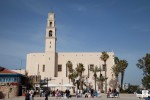
St. Peters Church in the old city of Jaffa
Jaffa (Joppa; Yafo)
(II Chronicles 2:15)
City on Mediterranean shore south of Tel Aviv, considered the world’s oldest port and the place from where the prophet Jonah set sail for Tarshish.
According to Greek myth, Andromeda was held captive by Poseidon on the rocks off Jaffa. Jaffa is also associated with the deeds of St. Peter. Here the woman disciple Tabitha was resurrected by Peter.
Legend claims Jaffa was built by Japheth, son of Noah, hence its name. Mentioned in the Bible and in Egyptian and Assyrian documents. Not captured by Joshua during his conquest. During the reign of King Solomon it served as a port for the united kingdom of Judah and Israel. After the return from the Babylonian Exile it was under Phoenician control, like the other coastal cities. During the Hellenistic Period it was at first an autonomous city and later subject to the district of Samaria. During the Hasmonean Period it was populated mainly by gentiles and their relationship with the local Jewish community was strained. One day the gentiles forced some 200 Jews out to sea and then drowned them. For this act, Judah Maccabee razed the port and slaughtered many inhabitants. Simeon the Hasmonean annexed it to his kingdom and during the reign of King Janneas the city prospered, particularly as a vital port. During the Revolt against Rome, Jewish sailors from Jaffa tried to prevent the Romans from sending supplies by sea. However, after the Roman victory, Jaffa became a Roman city and was called Flavia Ioppa. Jews continued to live here after the destruction of Second Temple, and in Roman and Byzantine Periods it was the home of many sages and scholars. Jaffa rose in importance during the Crusader Period. In 1268 it was taken by the Mamluk Sultan Baybars who destroyed its fortifications and killed its inhabitants. It was rebuilt only in the 17th century, serving mainly as an entry port for clomid-info.com and Jewish pilgrims. Captured and destroyed in 1799 by Napoleon after he besieged it.
In the 19th century pilgrim traffic to the Holy Land swelled and Jaffa recuperated. In 1950 Jaffa was amalgamated with Tel Aviv. When the Ashdod port was opened, the port of Jaffa ceased its commercial operations and became a harbor for fishing and sailing boats.
Part of the old city of Jaffa has been renovated and turned into an arts, crafts and leisure center.
Antiquities of Jaffa:
Excavations at Tel Jaffa uncovered Late Bronze Age and post-Babylonian Exile defensive walls. Within the old city a glacis, possibly dating from the Iron Age, was uncovered.
The many Medieval remains found include a synagogue, Jewish cemetery, churches, monasteries, mosques, Moslem tombs and a Crusader structure. The old port is today characterized by Ottoman architecture.



